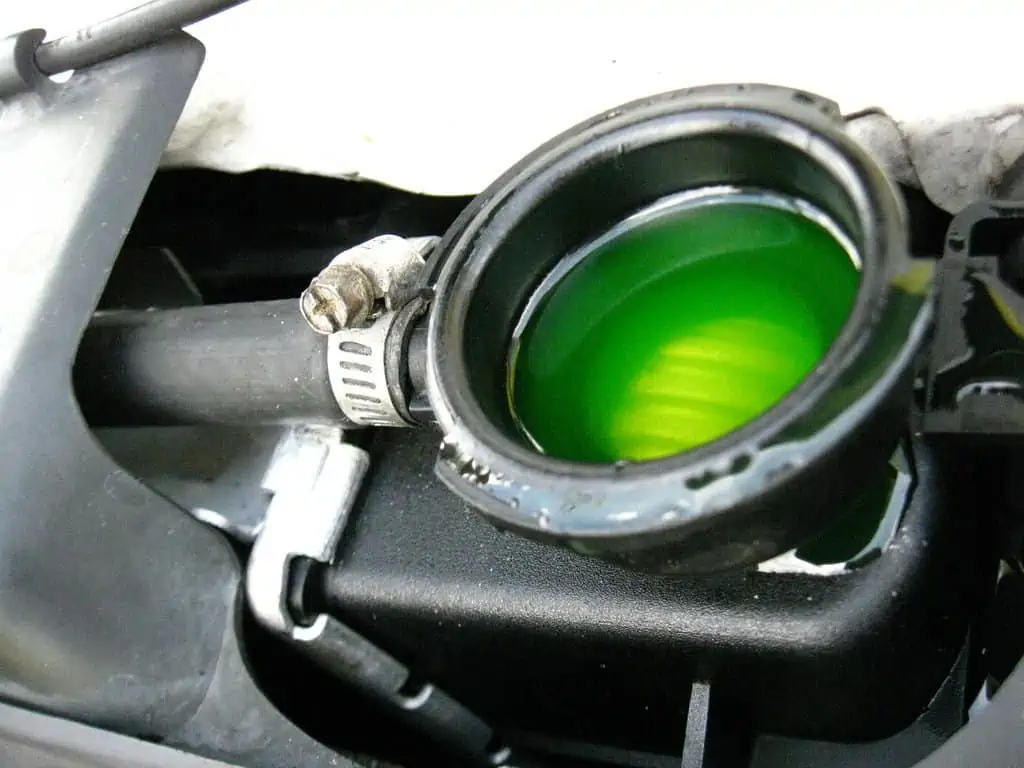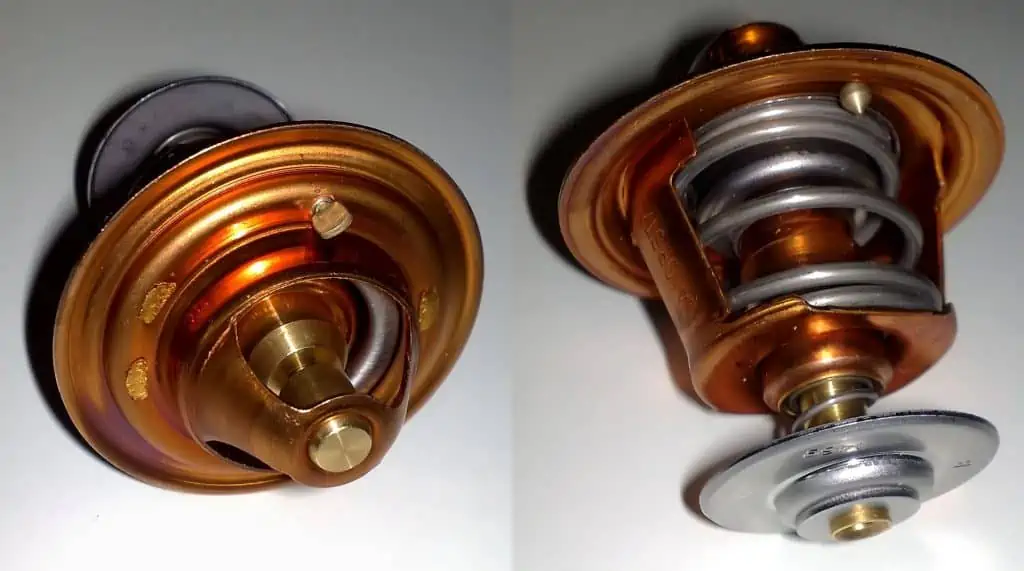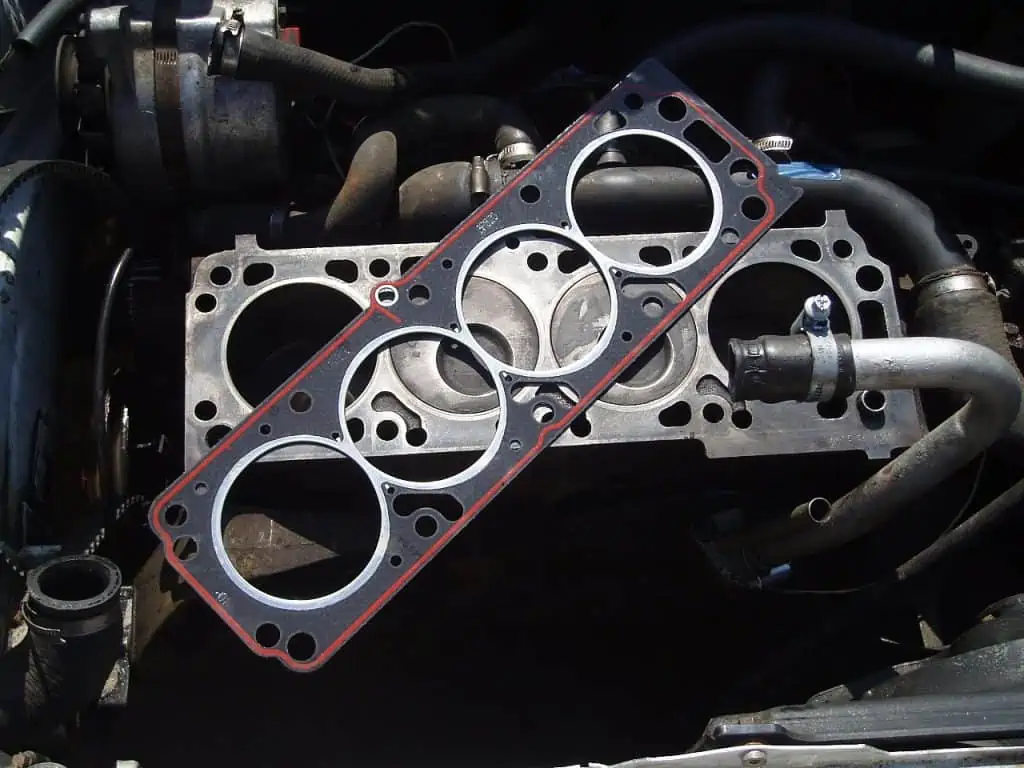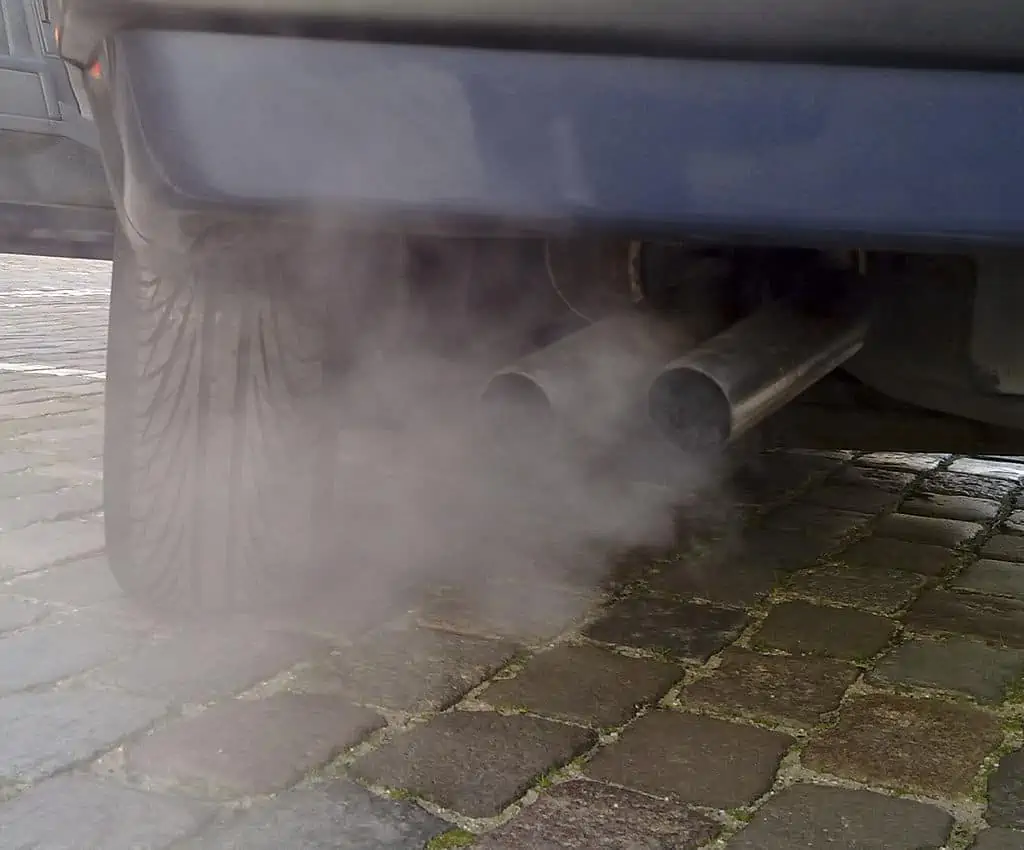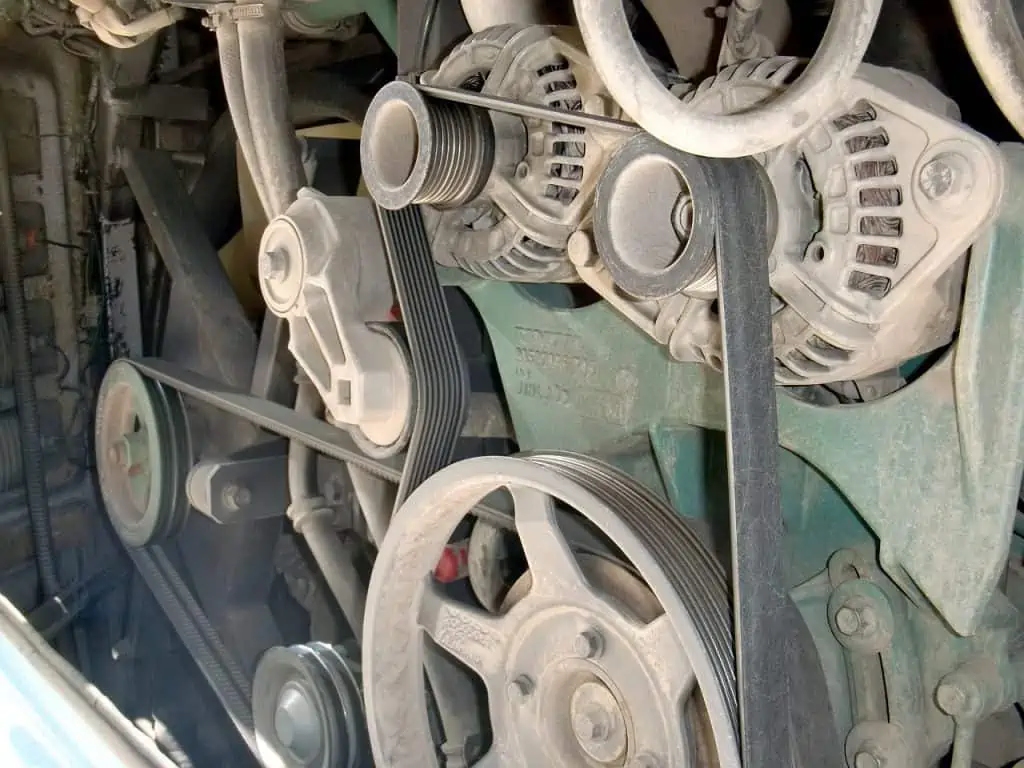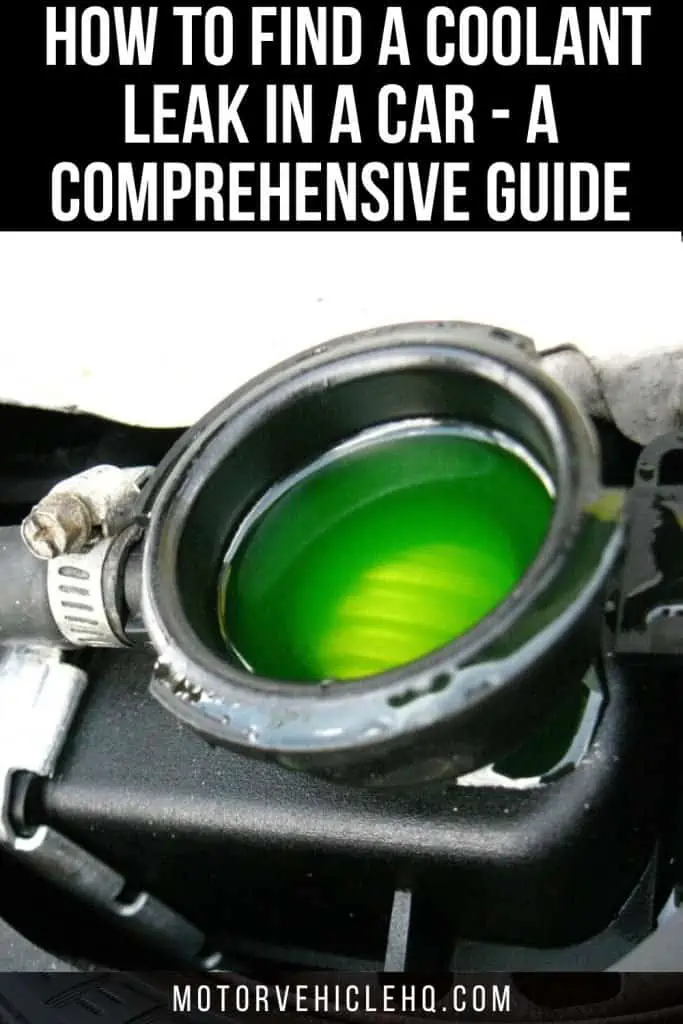Although coolant leaks may not appear serious, they could put the engine of your car in danger. Your engine could overheat if the right amount of antifreeze isn’t used (or freeze in winter months).
Coolant should be checked frequently because it is so important to how well your engine performs. This is particularly true for older vehicles, which might not function as well as more recent models.
The most obvious sign of a coolant leak is liquid on the garage floor or wherever you park your car. It’s critical to know what to look for to identify the sort of fluid leaking from your engine because it’s not the only one that can happen.
Coolant typically has a sweet smell and is bright green, orange, or pink in color. Coolant leaks should always be cleaned up right away because it is extremely harmful to both people and animals.
Monitoring your temperature gauge is another approach to finding out if you have a coolant leak. While some temperature fluctuation is natural, a sudden or considerable change in temperature is typically an indication that there is an issue that needs to be investigated before it causes damage.
Check the expansion tank’s coolant level, top it out, and then keep an eye on it to see if you’re losing fluid to determine if your engine leaks. Once you are certain that the leak is coolant, you can begin determining its source.
You have an engine cooling problem if you are driving and notice that your engine’s temperature is rising. The issue is typically caused by a lack of coolant.
Engine coolant in the radiator by EvelynGiggles / CC BY 2.0. Liquid on the garage floor or anywhere else you park the car is the most evident indicator of a coolant leak. There are other fluid leaks from engines that might occur, so it’s important to know what to look for to identify the type of fluid coming from your engine.
This is frequently brought on by a coolant leak in your car’s cooling system, which needs to be fixed right away. Running your automobile without enough coolant in it can seriously and expensively harm your engine.
An Automotive Engine Coolant: What Is It and What Does It Do?
A coolant removes heat by moving through your engine. The coolant will keep the engine at its ideal operating temperature by transferring heat away from various engine parts. The temperature gauge on your dashboard will display the coolant temperature, which for most cars will be between 180°F and 240°F.
Your automobile won’t be able to cool the engine without coolant since nothing will be able to remove the heat. Your temperature gauge will surge above 240°F at this point. As there isn’t enough coolant to remove the heat from your engine parts at this stage, you should pull over and halt your vehicle.
If you keep going, your engine will overheat and the internal parts will deteriorate. This will harm your engine severely and cost a lot of money over time.
How to Find a Coolant Leak In a Car: What Troubleshooting Methods Can You Use?
We advise initially checking your coolant level to identify the issue if your engine is overheated. Find the plastic tank that serves as the coolant reservoir for your car; it has a cap on top.
Open the reservoir cap once the car has cooled off and check to see if the coolant level has reached the “Maximum” sign. You don’t have a coolant leak if it does. Your issue may be with the thermostat or the water pump, but we will talk more about that later.
Refill it with a 50-50 mixture of coolant and water if the coolant level is low. Remember that some coolant is pre-mixed, so check it first before adding more. You won’t need to mix the coolant with water if it is pre-mixed.
Once it’s full, try starting the car once more. There is a leak in your cooling system if you observe the temperature rising again and the coolant level is already low. Identifying the leak’s location is necessary if this is the case.
You can detect a coolant leak in the following ways:
Finding a Leak of Coolant Externally
Checking for an exterior leak on your car should be simple. Once you’ve finished driving, park and switch off your vehicle. After that, wait 15 minutes and check under your car to see whether there is a coolant puddle.
If you find a pool of green fluid beneath your automobile, it means you have an exterior coolant leak because coolants are typically green in color. Check the coolant your automobile has been using because there are also red ones to be aware of.
It’s time to figure out where the leak is coming from now that you’ve established that there is an exterior leak. The three items you should examine are as follows:
The reservoir serves to hold hot coolant when the engine is running and the cooling system is under intense pressure. Once the engine has been turned off and the system pressure has dropped, the coolant is pumped back into the radiator.
1. Examine the Coolant Reserve Tank
When your engine is running and your cooling system is under tremendous pressure, the reservoir is there to store hot coolant. The coolant is fed back into the radiator once the engine has been shut off and the system pressure has decreased.
As a result, there are numerous temperature variations in the reservoir tank, also known as the expansion tank. This can cause the plastic to deteriorate and develop cracks over time.
Look for any flaws in the coolant reservoir tank that could lead to a coolant leak. The bleed hose that links the reservoir tank to the radiator should be checked if you can’t notice any breaks on the tank.
These rubber hoses could degrade over time as well, which could lead to a crack or loosening of the connection. It may leak coolant if there is a crack visible or if the connection is slack. In such a scenario, you’ll need to swap them out.
2. Examine the Car Radiator
The radiator itself should be checked once you have made sure the reservoir tank is functioning properly. The interior of the radiator will corrode with time, and debris damage might lead to a leak.
To check for leaks, check the radiator. Watch out for any white deposits or rust-colored spots, as well. These stains point to a dried-up leak. You have a radiator leak if you notice a leak or stains on your radiator.
Check the hoses that are attached to the radiator as well. They will deteriorate over time, form fractures, and lose their ability to seal effectively, just like the reservoir hose. Check to see if any coolant is dripping from these hoses.
3. Examine Your Car’s Radiator Cap
The radiator cap may also be to blame for your coolant leak. Despite being a minor part, it is crucial to the cooling system.
Finding a Leak of Coolant Internally
You might have an internal coolant leak if you can’t locate any external fluid leaks. If your engine is losing coolant fluid due to an internal coolant leak, your engine may be leaking coolant internally.
This typically occurs when the head gasket in your engine develops a crack. The head gasket serves as a seal between the cylinder head and engine block, allowing coolant to flow through to keep the engine cool while it is running.
You will gradually run out of coolant if your head gasket is cracked because the coolant will leak into the engine’s cylinder. Additionally, the mixture of the coolant and engine oil will harm the performance of both fluids.
Coolant in oil will decrease the oil’s lubricity, which will increase engine friction because the oil won’t be able to adequately lubricate the engine. The engine parts may sustain significant damage as a result over time.
Car engine coolant and radiator thermostat by Hoikka1 / CC BY-SA 3.0. A thermostat in the engine’s cooling system controls the main and bypass valves, which govern the flow of fluid into and out of your engine. If these valves fail, the thermostat won’t be able to control them properly.
The capacity of the coolant to transfer heat from your engine will be decreased if there is oil in the coolant. Therefore, not only will you lose coolant, but it will also work less effectively to cool down your engine.
Here’s how to determine whether you have a leaky head gasket (or, as we frequently hear, a blown head gasket):
1. Check the Oil In the Engine
Oil and coolant may mix as a result of a head gasket leak. Look at the dipstick to see how the oil in your engine is doing. Simply remove the dipstick, clean it, re-insert it, and pull it out once more.
Next, check the dipstick’s oil reading. If not clear, good engine oil should be light brown and not very thick. The oil has likely been combined with coolant if it is milky-colored or frothy. This indicates a head gasket breach since the coolant and oil are combined.
2. Check the Coolant for Oil Specks
Check the coolant within your radiator and reservoir tank by opening the cap. Do you notice any black flecks circling the coolant’s surface? If you do, it indicates that the coolant and engine oil have combined. Once more, the head gasket leak is to blame for the mixing of the two fluids.
3. Observe the Color of the Smoke from the Exhaust
As previously noted, coolant will leak into the engine’s cylinder as a result of a head gasket leak or ruptured head gasket. The coolant will be consumed when it enters the cylinders along with the fuel and air mixture.
When this occurs, your exhaust system will emit a dense, white cloud of smoke.
Small amounts of water that have accumulated inside the engine’s cylinder are normally the cause of clear white smoke, which is typically not abnormal. This typically occurs when you start your day cold.
However, you most likely have a head gasket issue if the white smoke continues even after a few minutes of idling, especially if the smoke is heavy.
Any of the aforementioned signs and symptoms point to an internal coolant leak in your engine.
Why Is the Coolant Low But There are No Leaks?
You may have an inside leak if you can’t locate an outward leak. However, occasionally the leak is so slight that you might not observe or detect the above-mentioned symptoms. We advise doing a leak-down test to check the engine’s cylinder compression to confirm the issue.
This test will help to confirm the issue because a blown head gasket can result in compression loss. However, bear in mind that several factors, including defective piston rings and valves, might result in compression loss. You can still tell if you have a blown head gasket from this, though.
Head gasket (in dark gray with a red border) by Collard / CC BY-SA 3.0. A cooling system pressure test is another helpful technique for identifying whether you have a head gasket leak. You can have an undetected exterior leak even if the engine’s cylinders passed the leak-down test without any problems. In any event, this test helps to identify the coolant leak issue.
A cooling system pressure test is then advised if there is no cylinder compression loss. This will determine if the cooling system leaks or not.
1. Finding a Leak Through the Leak-Down Test Procedure
To perform a leak-down test, you will need a leak-down tester. In this test, compressed air will be forced into each cylinder through the spark plug port to check if it will hold. You might have a blown head gasket if some of the cylinders don’t hold.
2. Finding a Leak Through Pressure Testing the Cooling System
Another useful method for determining whether you have a head gasket leak is to pressure test your cooling system. Additionally, even if the engine’s cylinders passed the leak-down test without issue, you can have an unnoticed external leak. This test, in any case, aids in confirming the coolant leak problem. A cooling system pressure test should be performed as follows:
- A cooling system pressure test kit must first be purchased. You may either buy one for roughly $60 or borrow or rent one from a nearby car shop. Because different vehicles have various radiator caps, be careful to choose one with adapters.
- Attach the test kit after removing the radiator cap. If necessary, make sure to use the right adaptor. In some cases, a radiator cap may not be present in a car, in which case you must take off the reservoir tank cap and attach the test kit to it in its place.
- After connecting, quickly pump the plunger to create pressure inside the system. Pump the plunger continuously until the gauge reads 14 PSI. Avoid exceeding 18 PSI because doing so could harm the system.
- There may be a leak in the system if the gauge is unable to maintain the pressure. Additionally, a coolant leak should be visible at 14 PSI that is if there are any leaks in the system.
Fixing Coolant Leak – How Is It Done and How Much Does It Cost?
You must repair the coolant leak once you have confirmed that it exists. Otherwise, your cooling system won’t function correctly, and if you keep driving, your engine may sustain significant and costly damage. Depending on where the leak is originating from, there are several procedures and expenses to correct a coolant leak.
You should be able to fix a radiator leak by simply utilizing a radiator leak sealer, which shouldn’t set you back more than $20. If this doesn’t work, though, you could need to replace your car’s radiator, which, depending on the make and type of your vehicle, can cost anywhere from $300 to $900.
If the reservoir tank is the cause of the problem, replacing it will run you about $130. Expect to pay about $220 for a new reservoir or expansion tank when labor charges are factored in.
A car engine is cooled by the coolant in the radiator by CEFICEFI / CC BY-SA 4.0. A coolant circulates through the engine to dissipate heat. By transporting heat away from various engine components, the coolant will maintain the engine at its proper operating temperature. The coolant temperature, which for most automobiles will be between 180°F and 240°F, will be shown on the temperature indicator on the dashboard.
For now, if you need a new radiator hose to fix the problem, budget about $170 for a new hose and labor. Remember that your cooling system contains multiple hoses, so if you need to replace more than one hose, the cost will be higher.
An Internal Leak Repair – How Is It Done?
This is when things become pricey if there is an interior leak, such as a head gasket leak. You can patch up the fracture in your head gasket if there is only a small leak by using a sealant like Bar’s Leak HG-1 Seal.
You can get this sealer for under $20 but bear in mind that it will only work on small cracks. Additionally, as they are temporary seals, you will eventually need to replace your head gasket.
A head gasket set normally costs between $200 and $500, but because replacing the head gasket is difficult and time-consuming, the overall cost of repair may range from $1,000 to $2,000.
This is because your mechanic will need to disassemble your engine’s top section, replace the head gasket, and then rebuild the engine. The duration of this procedure can range from two to three days.
While replacing a head gasket is expensive, it’s not something we advise doing on your own unless you have the necessary training because it’s incredibly simple to harm other engine parts while doing so.
What are the Main Causes of Coolant Leak In Cars?
An overheating car is frequently caused by a coolant leak. However, if you’ve checked for coolant leaks and found none, other parts may be to blame for your car’s overheating. It frequently results from either of these two factors:
1. A Broken Thermostat
The main and bypass valves, which regulate the flow of fluid into and out of your engine, are controlled by a thermostat in the cooling system of your engine. The thermostat won’t be able to appropriately manage these valves if they malfunction.
The coolant won’t be able to flow properly to and from your engine as a result. Both hot and cold coolants cannot flow into the radiator or the engine, respectively. Your temperature gauge will increase as a result.
You must replace your broken thermostat if it is the cause of the problem. Typically, they cost between $110 and $150 to buy. The replacement cost can reach $230 when labor is factored in.
2. A Malfunctioning Water Pump
Your engine’s coolant is pumped throughout by the water pump. The serpentine belt powers the water pump in the majority of autos.
The color of exhaust gas may signal a possible coolant leak by Ruben de Rijcke / CC BY-SA 3.0. A leaking head gasket or a damaged head gasket will allow coolant to enter the engine’s cylinder. When the fuel and air mixture enters the cylinders, the coolant will also be burned. Your exhaust system will then produce a thick, white cloud of smoke.
However, autonomous, electronically-operated water pumps can occasionally malfunction for no obvious cause. This happened to me lately with my 2015 Mercedes-Benz C-Class.
In any event, you will probably need to replace your water pump if it is leaking or not functioning anymore. The median cost to replace a water pump ranges from $450 to $650, and the average cost of a car is $550.
Repair of Coolant Leaks
Over time, the interior of the radiator in your car will rust. Your cooling system may be damaged by sediment and debris when they are transported and circulated within it, frequently leading to a leak.
The majority of cooling systems have a minimum lifespan of three years. The cooling system of an automobile, however, can easily survive up to 10 years without needing any repairs with regular maintenance. The following actions you should do will help the cooling system in your car last longer:
1. Fix the Radiator Cap Tightly
You shouldn’t need to replace the radiator cap for more than ten years. Only in extreme circumstances, as when rust has amassed inside the radiator, would you need to replace it.
Just be sure to routinely check your radiator cap to make sure it is closed and securely fastened. Since the radiator cap helps regulate cooling system pressure, it must be tightly closed.
2. Clean Out the Radiator
As previously discussed, your radiator will corrode and get dusty over time. Flushing the radiator can help keep your cooling system clean and functioning properly by reducing dirt and debris inside the radiator.
Generally speaking, you should cleanse the radiator in your car every five years or 30,000 miles. Check your manual, though, to see what the manufacturer advises.
A radiator flush typically costs $150, which also includes the price of the fresh coolant you’ll need to add to the system.
3. Install a New Serpentine Belt
The power steering pump, alternator, and water pump are just a few of the components that your car’s serpentine belt drives. To avoid having the automobile break down while you’re driving, be sure to change the belt before it breaks. Examine the belt for cracks and other signs of degradation.
Additionally, when you drive, a slipping belt will generate a squealing sound. If the belt starts to squeal, you should check its tension. If there are any signs of damage, you may need to replace the belt entirely.
The lifespan of a serpentine belt is 60,000 to 100,000 miles. If your car has achieved this mileage, you should therefore frequently check its serpentine belt. Replacement of a serpentine belt typically costs $200.
A typical car serpentine belt by Miya.m / CC BY-SA 3.0. The serpentine belt in the car operates several parts, including the water pump, alternator, and power steering pump. Make sure to change the belt before it breaks to avoid having the car break down while you’re driving. Look for cracks and other signs of wear and tear on the belt.
How Safe Is It to Drive When the Engine Coolant Is Leaking?
How long is a leaky antifreeze safe to drive with? We advise having it fixed as soon as you can. Cooling system issues don’t resolve themselves and might grow worse very quickly. You don’t want to end up stranded on the side of the road as a result of ignoring an antifreeze leak’s early warning indications.
If you’re the kind to press your luck, you might be able to drive for a few days by topping off the cooling system with water whenever it gets low if you have a modest (slow) coolant leak and it’s summer.
However, it’s always advisable to top off a cooling system with the right mixture of antifreeze and water in a 50-50 ratio, particularly in the winter. On a bitterly cold winter night, plain water that is left in an engine freezes and expands.
That expansion may easily split cooling system hoses, crack an engine block, or even burst a radiator, which would completely wreck your engine.
To prevent damage, antifreeze reduces the coolant’s freezing point to somewhere about minus 35 degrees Fahrenheit. Once more, it’s much best to have your car inspected as soon as you can to avoid more severe and costly engine damage.
Last but not least, various automobiles require various kinds of antifreeze. Antifreeze is available in three primary varieties: the more traditional ethylene glycol (green dye), the brighter propylene glycol (orange or yellow dye), and the most recent hybrid organic acid technology (yellow, green, pink, blue, violet, or orange).
The various categories cannot be combined. For the proper replacement kind, consult your owner’s manual or the dealer’s.
The Conclusion
When your vehicle overheats, the issue is frequently due to a coolant shortage, which is brought on by a coolant leak in the cooling system. A cooling system pressure tester kit can help you locate the source of an exterior coolant leak, which should be simple to detect.
If you are unable to locate an exterior leak, the issue can be an inside leak brought on by a damaged or blown head gasket. By keeping an eye out for symptoms and performing a leak-down test, you can confirm this.
If there are no coolant leaks, you will need to replace the thermostat or the defective water pump if your vehicle is overheating.
Your car’s cooling system may endure a long time with proper maintenance, just like any other component. Make sure to heed our advice on how to keep your cooling system in good shape, and your car should last a long time.
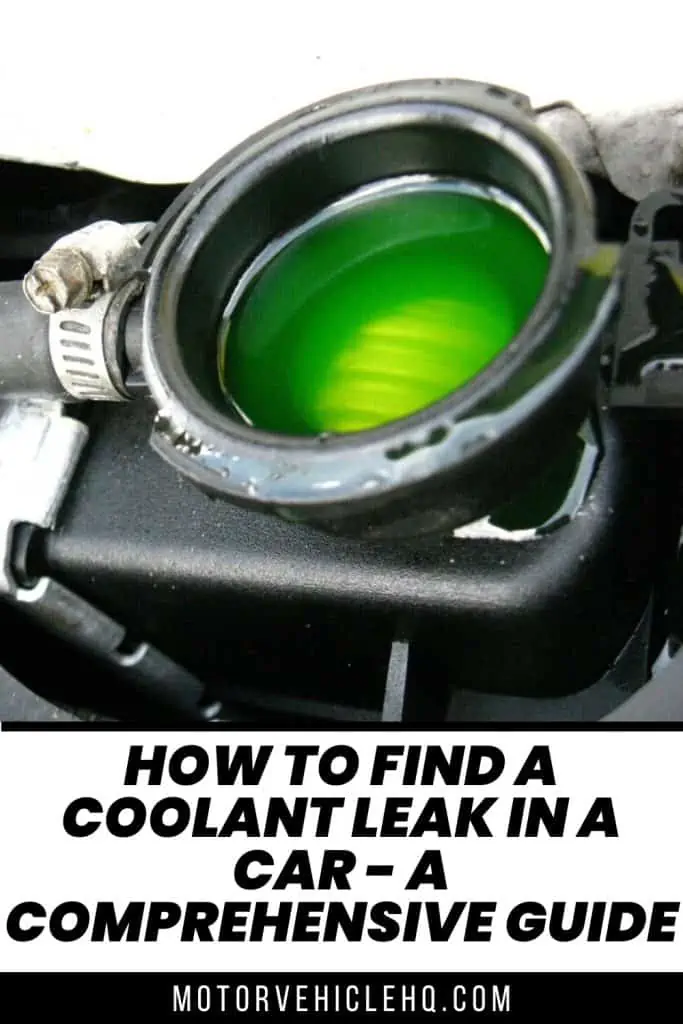
Engine coolant in the radiator by EvelynGiggles / CC BY 2.0

Jim Wicks is the founder of MotorVehicleHQ. With over two decades of experience in the automotive industry and a degree in Automotive Technology, Jim is a certified car expert who has worked in various roles ranging from a mechanic, car dealership manager, to a racing car driver. He has owned more than 20 cars over the past 15 years. Ask him about any vehicle you see on the road and he can tell you the make, model and year. He loves the aesthetics of all things cars, and keeps his vehicles in pristine condition.
In his free time, Jim enjoys getting his hands dirty under the hood of a classic car or taking long drives along the country roads. His favorite car? A 1967 Shelby GT500, a true classic that, according to Jim, “represents the pure essence of American muscle.”
